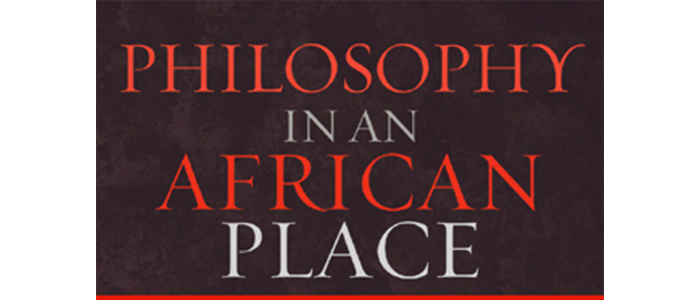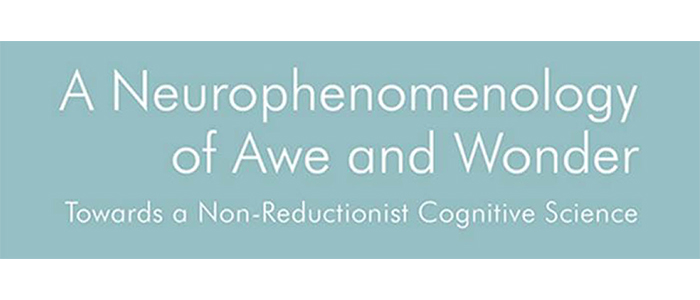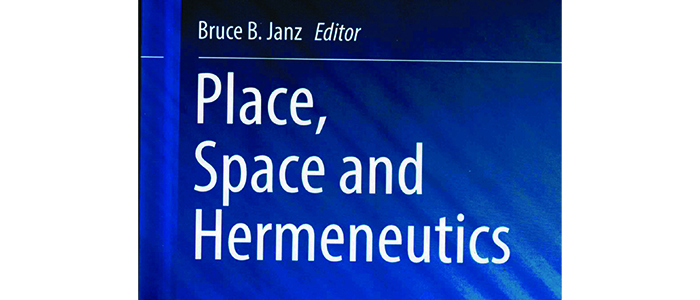There are literally thousands of entries and hundreds of courses in the sub-area of psychology called environmental psychology. Many of these deal with issues of place and space. I will not attempt to include everything, but I will include important work and portal sites. As always, I appreciate finding out about good resources from people who work in the field.
Websites
- Axiomatics of Spatial Concepts: Formal Specification of Spatial Concepts and Structures with Definitions and Axiomatic Characterizations
- Environmental Psychology
- Environmental Psychology Links
- European Qualitative Spatial Reasoning Network
- Familiar Stranger Project (Eric Paulos and Elizabeth Goodman)
- Growing Up In Cities (UNESCO Site)
- IAAP: Environmental Psychology
- Place Psychology
- Psychology of Home and Neighbourhood: Psychological Approaches.
- Spatial Cognition Priority Program
- Spatial Intelligence Home Page
- Transactional and Phenomenological Theories of Place in Environmental Psychology.
Home Pages of People in Place Research
Journals
- Environment and Behaviour
- Health and Place
- Journal of Environmental Psychology
- Journal of Psychogeography and Urban Research
On-line Bibliographies
- Childhood Places and Experience of Place (Gene Myers)
- Development of Perception and Thought About Space and Place (Gene Myers)
- General Sources on Place Perception and Environmental Psychology (Gene Myers)
- Louise Chawla Bibliography
- R. B. Taylor Bibliography
Courses and Programs
- Environmental Psychology (John Davis)
- Environmental Psychology (Chris Jazwinski)
- Environmental Psychology (Chris Spencer)
General Bibliography
Aiello, J. “Human Spatial Behaviour” in D. Stokols, I. Altman, eds. Handbook of Environmental Psychology. New York: John Wiley, 1987: 389-504.
Aitken, S. C. & Ginsburg, S P. “Children’s characterization of place.” Association of Pacific Coast Geographers Yearbook 50 (1988): 69-86.
Altman, Irwin & Setha M. Low, eds. Place Attachment. New York: Plenum Press, 1992.
Andrews, C. J. “Analyzing quality-of-place.” Environment and Planning B: Planning and Design 28:2 (2001): 201-217.
Baird, Carol L., & Bell, Paul A. “Place attachment, isolation, and the power of a window in a hospital environment.” Psychological Reports 76 (1995): 847-850.
Benson, Ciarán. The Cultural Psychology of Self: Place, Morality and Art in Human Worlds. London: Routledge, 2001.
Bernard, Yvonne. “Connaître et se représenter un ‘espace'”. http://www.archivue.net/lectures/textes/simulespace.html
Binswanger, Ludwig. “Der Raum-problem in der Psychopathologie.” Zeitschrift fur Neurologie (1933): 145ff.
Blades, M & C. P. Spencer. “The implications of psychological theory and methodology for cognitive cartography.” Cartographica 23 (1986): 1-13.
Blades, M & C. P. Spencer. “Map use in the environment, and educating children to use maps.” Environmental Education and Information 5 (1986): 187-204.
Blades, M. & C. P. Spencer. “Young children’s recognition of environmental features from aerial photographs and maps.” Environmental Education and Information 6 (1987): 189-198.
Blades, M & C. P. Spencer. “Young children’s strategies when using maps with landmarks.” Journal of Environmental Psychology 7 (1987): 201-218.
Blades, M. & C. P. Spencer. “The development of children’s ability to use spatial representations.” Advances in Child Development and Behavior 25 (1994): 157-197.
Canter, David. The Psychology of Place. New York: St. Martin’s Press, 1977.
Canter, D. “The facets of place.” in G T Moore & R W Marans (eds) Advances in Environment, Behavior, and Design. Volume 4. Towards the Integration of Theory, Methods, Research and Utilization. New York. Plenum, 1997: 109-148.
Cartier, C. “From home to hospital and back again: economic restructuring, end of life, and the gendered problems of place-switching health services.” Social Science and Medicine 56:11 (June 2003): 2289-2301.
Case, Duncan. “Contributions of Journeys Away to the Definition of Home: An Empirical Study of a Dialectical Process. Journal of Environmental Psychology 16:1 (Mar 1996): 1-15.
Casey, E. S. “From space to place in contemporary health care.” Social Science and Medicine 56:11 (June 2003): 2245-2247.
Chawla, Louise. “Ecstatic places.” Children’s Environments Quarterly 7:4 (1990): 18-23.
Chawla, Louise. “Childhood Place Attachments” in Altman, Irwin & Setha M. Low, eds. Place Attachment. New York: Plenum Press, 1992: 63-86.
Chawla, Louise. In the First Country of Places: Nature, Poetry and Childhood Memory. Albany, NY: SUNY Press, 1994.
Chawla, Louise. “Special place?–What is that? Significant places in the lives of children in a Johannesburg squatter camp” Michigan Quarterly Review 39:2 (2000): 378-398.
Crompton, A. “The fractal nature of the everyday environment.” Environment and Planning B: Planning and Design 28:2 (2001): 242-254.
Day, Matthew. Home in the Western World: A Cultural-Hermeneutical Study. Ph.D. Dissertation, Dept. of Psychology, Duquesne University, Pittsburgh, 2002.
Day, Matthew. “Home in Postmodern Culture” Environmental and Architectural Phenomenology 14:2 (Spring 2003): 8-10.
Deregowski, J. B. “Real Space and Represented Space: Cross-Cultural Perspectives” Behavioral and Brain Sciences 12:1 (March 1989): 51-74.
Derr, Victoria. “Children’s Sense of Place in Northern New Mexico.” Journal of Environmental Psychology 22:1/2 (Mar 2002): 125-137.
Devereax, Paul. “Cognitive Geography: Place and Mind” http://www.acemake.com/PaulDevereux/cognitive.html
Dixon, J. & Durrheim, K. “Displacing place-identity: A discursive approach to locating self and other.” British Journal of Social Psychology 39 (2000): 27-44.
Dovey, K. “Refuge and imagination: Places of peace in childhood.” Children’s Environments Quarterly 7:1 (1990): 13-17.
Duerckheim, K. von. “Untersuchungen zum gelebten Raum.” Neue Psychologische Studien 6 (1932).
Earles, Wendy. “Spaces for empowered places or agents of displacement? The contribution of the Third Sector in the increasing displacement of the human services.” http://www.jhu.edu/~istr/conferences/geneva/confpapers/wendy.earles.html
Eilan, Naomi, Bill Brewer and Rosaleen McCarthy, eds. Spatial Representation. Oxford University Press, 1993.
Elder, G. H., V. King, R. D. Conger. “Attachment to place and migration prospects: A developmental perspective.” Journal of Research on Adolescence 6 (1996): 397-425.
Evans, Gary. “Current Trends in Environmental Psychology.” http://www.ucm.es/info/Psyap/iaap/evans.htm
Feldman, R. “Settlement-Identity: Psychological Bonds with Home Places in a Mobile Society.” Environment and Behavior 22 (1990): 183-229.
Fiore, Stephen and Jonathan W. Schooler. “How Did You Get Here from There? Verbal Overshadowing of Spatial Mental Models.” Applied Cognitive Psychology 16 (2002): 897–910.
Fishwick, L., & Vining, J. “Toward a phenomenology of recreation place.” Journal of Environmental Psychology 12 (1992): 57–63.
Fried, Marc. “Continuities and Discontinuities of Place.” Journal of Environmental Psychology 20:3 (Sep 2000): 193-205.
Foreman, Nigel and Raphael Gillett. A handbook of spatial research paradigms and methodologies. East Sussex, U.K.: Psychology Press, 1997.
Fullilove, M. T. “Psychiatric Implications of Displacement: Contributions from the Psychology of Place.” American Journal of Psychiatry 153 (1996): 1516-1523.
Langevelt, M. J. “The Stillness of the Secret Place” and “The Secret Place in the Life of the Child” in Phenomenology and Pedagogy I (1983): 10-17, 180-191.
Gallagher, W. The power of place: how our surroundings shape our thoughts, emotions, and actions. New York, N.Y.: Harper-Perennial, 1993.
Gattis, Merideth, ed. Spatial Schemas and Abstract Thought. Cambridge: MIT Press, 2003.
Genereux, R.L., L.M. Ward and J.A. Russell, “The behavioral component in the meaning of places.” in Groat, Linda, ed. Giving Places Meaning. London: Academic Press, 1995.
Gibson, J. J. The Ecological Approach to Visual Perception. Boston: Houghton Mifflin, 1979.
Godkin, Michael. “Identity and Place: Clinical Applications Based on Notions of Rootedness and Uprootedness.” in Buttimer, Anne & David Seamon, eds. The Human Experience of Space and Place. London: Croom Helm, 1980: 73-85.
Guliani, M. V. & Feldman, R. “Place attachment in a developmental and cultural context.” Journal of Environmental Psychology 13(1993): 267-274.
Gustafson, Per. “Meanings of Place: Everyday Experience and Theoretical Conceptualizations.” Journal of Environmental Psychology 21:1 (Mar 2001): 5-16.
Groat, Linda, ed. Giving Places Meaning. London: Academic Press, 1995.
Giuliani, M.V., and R. Feldman. “Place attachment in a developmental and cultural context.” Journal of Environmental Psychology 13 (1993): 267-274.
Halford S.; Leonard P. “Space and place in the construction and performance of gendered nursing identities.” Journal of Advanced Nursing 42:2 (April 2003): 201-208.
Harris, P. B., Brown, B. B., & Werner, C. M. “Privacy regulation and place attachment: Predicting attachments to a student family housing facility.” Journal of Environmental Psychology 16 (1996): 287-301.
Hart, R. Children’s experience of place. New York: Irvington Publishers, 1979.
Hart, R. “The geography of children and children’s geographies.” In T. Saarinen, D. Seamon & J. Sell, Environmental Perception and Behavior. Research Papers, University of Chicago: Dept. of Geography, vol. 209, 1984.
Hay, R. “Sense of place in developmental context.” Journal of Environmental Psychology 18 (1998): 5-29.
Hidalgo, M. Carmen & Bernardo Hernèndez. “Place Attachment: Conceptual and Empirical Questions.” Journal of Environmental Psychology 21(2001): 273-281. http://www.unb.br/ip/lpa/arquivos_pdf/0221a.pdf
Hubiak, Hubiak and James H. Banning. “The Implications of Place Attachment for Campus Workplaces.” http://isu.indstate.edu/wbarratt/dragon/ce/v12n3.htm
Hutchins, Edwin. Cognition in the Wild. Cambridge, MA: MIT Press, 1995.
Israel, Toby. Some Place Like Home: Using Design Psychology to Create Ideal Places. NY: Wiley, 2003.
Jemstedt, A. “Potential Space – The Place of Encounter between Inner and Outer Reality.” International Forum of Psychoanalysis 9:1-2 (16 February 2000): 124-131.
Kearns, R. A. & A. E. Joseph. “Space in its place: developing the link in medical geography.” Social Science & Medicine 37:6 (1993): 711-717.
Kelly, S. E. “Bioethics and rural health: theorizing place, space, and subjects.” Social Science and Medicine 56:11 (June 2003): 2277-2288.
Robin A. “To boldly go? Place, metaphor, and the marketing of Auckland’s Starship Hospital.” Environment and Planning D-Society & Space 17:2 (1999): 201-226.
Kaufmann, S. R. “Hidden places, uncommon persons.” Social Science and Medicine 56:11 (June 2003): 2249-2261.
Kearns R.A.; Ross Barnett J.; Newman D. “Placing private health care: reading Ascot hospital in the landscape of contemporary Auckland.” 2303-2315
Kitchin, R.M. “Exploring spatial thought.” Environment and Behaviour 29:1(1997): 123-156.
Komesaroff, Paul A. Troubled bodies: critical perspectives on postmodernism, medical ethics, and the body. Durham: Duke University Press, 1995.
Korosec-Serfaty, Perla. Appropriation de l’espace 76 – actes de la 3ème conférence internationale de psychologie de l’espace construit de strasbourg.
Korosec-Serfaty, Perla. “Expérience et pratiques de la maison.” Altman, Irwin & Carol M. Werner. Home Environments: Human Behavior and Environment. Advances in Theory and Research. New York: Plenum Press: 1985: 65-86. http://www.perlaserfaty.net/images/Exp%E9rience%20et%20pratiques%20de%20la%20maison.doc
Korosec-Serfaty, Perla. La grand’place, identité et pratiques quotidiennes d’un espace public urbain. Editions du CNRS.
Korosec-Serfaty, P. “The home from attic to cellar.” Journal of Environmental Psychology 4 (1984): 303-321.
Korpela, K. & Hartig, T. “Restorative qualities of favourite places.” Journal of Environmental Psychology 16 (1996): 221-233.
Korpela, K.M. “Place-identity as a product of environmental self-regulation.” Journal of Environmental Psychology 9 (1989): 241-256.
Kramer, B. “Classification of generic places: explorations with implications for evaluation.” Journal of Environmental Psychology 15:1 (1995): 3-22.
Kyle, G.T., J.D. Absher, and A.R. Graefe. “The Moderating Role of Place Attachment on the Relationship Between Attitudes Toward Fees and Spending Preferences.” Leisure Sciences, forthcoming.
Lalli, M. “Urban-related identity.” Journal of Environmental Psychology 12 (1992): 285-304.
LeStrange, R. Speaking Through Our Place Attachments: Home and Journey as a Process of Psychological Development. Doctoral dissertation, Department of Clinical Psychology, Pacifica Graduate Institute, Carpinteria, California, 1998.
Majid, Asifa, Melissa Bowerman, Sotaro Kita, Daniel B. M. Haun, Stephen C. Levinson. “Can Language Restructure Cognition? The Case for Space.” in Trends in Cognitive Science 8:3 (March 2004): 108-114.
Malone, R. E. “Vulnerable places: contextualizing health practices.” Social Science and Medicine 56:11 (June 2003): 2243-2244.
Malpas, Jeffrey. “Bio-medical Topoi-the dominance of space, the recalcitrance of place, and the making of persons.” Social Science and Medicine 56:11 (June 2003): 2343-2351.
Martin, P. Y. “Sensations, bodies, and the ‘spirit of a place’: Aesthetics in residential organizations for the elderly.” Human Relations 55:7 (July 2002): 861-885.
Matthews, M. Making sense of place: Children’s understanding of large-scale environments. New York: Rowman & Littlefield, 1992.
McAndrew, F. T. “The measurement of ‘rootedness’ and the prediction of attachment to home-towns in college students.” Journal of Environmental Psychology 18 (1998): 409-417.
Metzner, Ralph. “The Place and the Story: Bioregionalism and Ecopsychology.” http://www.rmetzner-greenearth.org/ecopsych.html
Milligan, Christine. Geographies of Care: Space, Place and the Voluntary Sector. Ashgate Publishers, 2001.
Minami, H., and K. Tanaka. “Social and environmental psychology: transaction between physical space and group-dynamic processes.” Environment and Behaviour 27:1 (1995): 43-55.
Moore, R. L., & Graefe, A. R. “Attachments to recreation settings: the case of rail-trail users.” Leisure Sciences 16 (1994): 17-31.
Moore, Jeanne. “Placing Home in Context.” Journal of Environmental Psychology 20:3 (Sep 2000): 207-217.
Nabhan, Gary Paul & Steven Trimble. The Geography of Childhood: Why Children Need Wild Places. Boston: Beacon Press, 1994.
Newcombe, Nora S. and Janellen Huttenlocher. Making Space: The Development of Spatial Representation and Reasoning. Cambridge: MIT Press, 2003.
Newell, Patricia Brierl. “A cross-cultural examination of favorite places.” Environment and Behaviour 29:4 (July 1997): 495-515.
Parr, H. “Delusional geographies: The experiential worlds of people during madness/illness.” Environment and Planning D: Society and Space 17:6 (1999): 673-690.
Paulos, Eric and Elizabeth Goodman. “The Familiar Stranger: Anxiety, Comfort and Play in Public Places. I” http://berkeley.intel-research.net/paulos/pubs/papers/Familiar%20Stranger%20(CHI%202004).pdf
Paulos, Eric and Elizabeth Goodman. “The Familiar Stranger: Anxiety, Comfort and Play in Public Places. II” http://berkeley.intel-research.net/paulos/pubs/papers/Familiar%20Stranger%20IR%20Tech%20Report.pdf
Peard, Julyan G. Race, Place, and Medicine: The Idea of the Tropics in Nineteenth-Century Brazil. Duke University Press, 1999.
Peponis, J., C. Zimring, Y. K. Choi. “Finding the Building in Wayfinding.” Environment and Behaviour 22 (1990): 555-590.
Peter, Elizabeth. “The history of nursing in the home: revealing the significance of place in the expression of moral agency.” Nursing Inquiry 9:2 (June 2002): 65ff.
Piaget, Jean & Bärbel Inhelder. The Child’s Concept of Space. New York: Norton Library, 1967.
Pile, Steve. The body and the city: psychoanalysis, space, and subjectivity. New York: Routledge, 1996.
Pred, Allan. “Structuration and Place: On the Becoming of Sense of Place and Structure of Feeling.” Journal for the Theory of Social Behaviour 13 (1983): 45-68.
Proshansky, H. M. “The City and Self-Identity.” Environment and Behaviour 10 (1978): 147-170.
Proshansky, H.M., A.F. Fabian, and R. Kaminoff. “Place-identity: physical world socialization of the self.” Journal of Environmental Psychology 3:1 (1983): 57-83.
Reed-Danahay, Deborah. “‘This is Your Home Now!’: Conceptualizing Location and Dislocation in a Dementia Unit.” http://www.sagepub.co.uk/journals/details/issue/sample/a015891.pdf
Reilly, Marie. A Phenomenology of Place: The Journal of an Itinerant Learner. Dissertation. Fielding Institute, 2000.
Révész, Géza. “The Problem of Space with Particular Emphasis on Specific Sensory Spaces.” American Journal of Psychology 50(1937): 429-444.
Russell, D. “A Psychological Perspective on Place.” http://sites.uws.edu.au/research/SERG/PsychPersPlace_russell.htm
Seamon, D. “The Phenomenological Contribution to Environmental Psychology.” Journal of Environmental Psychology 2 (1982): 119-140.
Seamon, D. “Phenomenology and Environment-behavior Research.” in G. T. Moore and E. Zube, eds., Advances in Environment, Behavior and Design, vol. l. New York: Plenum, 1987: 3-27.
Seamon, D. “Humanistic and Phenomenological Advances in Environmental Design.” Humanistic Psychology 17 (1989): 280-293.
Seamon, David. “A Way of Seeing People and Place: Phenomenology in Environment-Behavior Research,” in S. Wapner, J. Demick, T. Yamamoto, and H Minami (Eds.), Theoretical Perspectives in Environment-Behavior Research. New York: Plenum, 2000: 157-78. A shortened version of the unpublished paper “Phenomenology, Place, Environment, and Architecture: A Review of the Literature”.
Sime, J. D. “Creating places or designing spaces?” Journal of Environmental Psychology 6 (1986): 49-63.
Smernou, L. E. Exploring the components of the self: Assessment of the Place Identity Construct. Doctoral dissertation, Univ. of Georgia, Athens, 1992.
Smith, G. “Coming home: What childhood memories reveal about the experience of place.” Clearing 96 (Jan-Feb 1997): 7-10.
Sobel, D. “A place in the world: Adults’ memories of childhood’s special places.” Children’s Environments Quarterly 7:4 (1990): 5-12.
Sobel, David. Children’s Special Places: Exploring the Role of Forts, Dens, and Bush Houses in Middle Childhood. Tucson, AZ: Zephyr Press, 1993.
Sobel, David. Mapmaking with Children: Sense of Place Education for the Early Years. Portsmouth, NH: Heinemann, 1998.
Sommer, Robert. Personal Space: the Behavioral Basis of Design. Englewood Cliffs, NJ: Prentice-Hall, 1969.
Spencer, C. P. & Z. Darvizeh. “Young children’s place descriptions, maps and route finding: A comparison of nursery school children in Iran and Britain.” International Journal of Early Childhood 15 (1983): 26-31.
Spencer, C. P. & M. Blades. “How children navigate.” Journal of Navigation 38 (1985): 445-453.
Spencer, C. P. & M. Blades. “Children’s understanding of places: the world at hand.” Geography 78 (1993): 367-373.
Spivak, Mayer. “Archetypal place.” Architectural Forum (October 1973): 44-49.
Stefanovic, Ingrid Leman. “Phenomenological Encounters with Place: Cavtat to Square One.” Journal of Environmental Psychology 18 (1998): 31-44.
Stokols, D., and S.A. Shumaker. “People in places: a transactional view of settings.” In Harvey, J. H., ed. Cognition, social behavior, and the environment. Hillsdale, NJ: Lawrence Erlbaum Associates, Publishers, 1981.
Stoller, N. “Space, place and movement as aspects of health care in three women’s prisons.” Social Science and Medicine 56:11 (June 2003): 2263-2275.
Strauss, E. “Die Formen des Raumlichen: Ihre Bedeutung fuer die Motorik und die Wahrnehmung.” Der Nervenarzt 3 (1930).
Sundararajan, Louise “Dwelling after Heidegger.” International Society for Theoretical Psychology, Berlin Conference. 1.1.2001. http://www.focusing.org/sundararajan.html
Teague, Rodney. “Intimate Immensity in the Preschool Playroom: A Topo-Analysis of Children’s Play.” Environmental and Architectural Phenomenology 16:1 (Winter 2005): 10-15. http://www.arch.ksu.edu/seamon/Teague.htm
Telfer, James. “Discovering Time and Place.” http://www.funzionegamma.edu/magazine/settimonumero/inglese/telfer.htm
Twigger-Ross, C.I., and D.L. Uzzell. “Place and identity processes.” Journal of Environmental Psychology 16 (1996): 205-220.
Ungar, Simon. “Cognitive Mapping without Visual Experience.” http://www.surrey.ac.uk/~pss1su/research/papers/cmppf.html
Ungar, Simon. “Comparative Spatial Cognition.” http://www.surrey.ac.uk/~pss1su/lecturenotes/lgu/compsp/
Wallenius, Marjut. “Personal Projects in Everyday Places: Perceived Supportiveness of the Environmental and Psychological Well-Being.” Journal of Environmental Psychology 19:2 (Jun 1999): 131-143.
Warin M.; Baum F.; Kalucy E.; Murray C.; Veale B. “The power of place: space and time in women’s and community health centres in South Australia.” Social Science and Medicine 50:12 (June 2000): 1863-1875.
Williams, Allison, ed. Therapeutic Landscapes: the Dynamic Between Place and Wellness. University Press of America, 1999.





